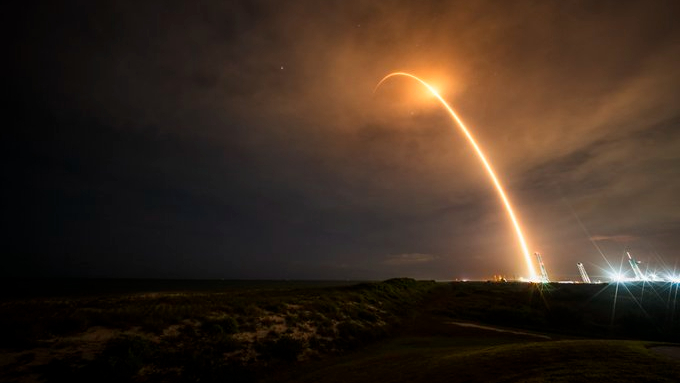The “Everyday Astronaut” turns out to be a not-so-everyday kind of person.
Talented Tim Dodd is the central spark plug behind the Internet-streamed show “Everyday Astronaut,” dedicated to “bring space down to Earth for everyday people.”
Born in 1985, Dodd and his team provide video updates on space and captivating interviews with leading rocketeers, including Elon Musk and the SpaceX Starship program. Indeed, Dodd and Musk have proven to be a powerful duo in showcasing what goes on behind the scenes with Starship’s development.
Admittedly a late bloomer in recognizing his space and rocket boosterism, Dodd transitioned from a professional photographer career to start Everyday Astronaut in 2014 as an art project on Instagram. But his love for spaceflight soon reached escape velocity, and propelled him into obsession orbit.
In 2017, Dodd took to YouTube, posting videos produced to enthrall and educate the public about spaceflight. The Everyday Astronaut production team grew and in 2019 flourished more so by website development and by churning out top notch videos, like those with former NASA chief, Jim Bridenstine and Rocket Lab‘s Peter Beck.
For Dodd, the future looks bright — particularly thanks to the glow of a SpaceX Starship lighting up and launching. He was selected to participate in a lunar spaceflight as part of the dearMoon project crew, one of the eight selected to take the journey in the near-future aboard a Starship.
Space.com caught up with Dodd in an exclusive interview to discuss his Everyday Astronaut status, thoughts on space entrepreneurs, and how he’s preparing himself for his citizen voyage to the moon and back.

Tim Dodd, also known as Everyday Astronaut, is an American science communicator, YouTube content creator, photographer, and musician. In 2022, Dodd was chosen as a crew member for dearMoon, the first-ever civilian mission to the moon.
Space.com: It seems like your passion for space evolved rapidly. How did your show come to be?
Dodd: I’m a bit of a college dropout and ended up being a professional photographer for about 8 years or so. I’ve always liked mechanical things and enjoyed working on cars and motorcycles growing up. My dad was an engineer. So I always had my hands dirty, building and fixing things. I got really interested in turbochargers and performance cars that had turbochargers. I like things that go fast … and nothing goes faster than a rocket. It’s kind of the ultimate version of horsepower and power. It was a photo assignment to shoot the SpaceX CRS-3 [Commercial Resupply Service mission] that got me up close and personal to hardware. It kind of hit me across the face. I was inspired and excited.
Space.com: Is there a message in your show that you want audiences to appreciate?
Dodd: I think people get excited about things when they are educated about things, when they get their questions answered. And that’s when they get their curiosity going. That little light bulb goes off in their head.
I’m still learning as fast as I possibly can each day. I still feel like I have a million things to learn.

Space.com: Just how technical can you be for your audience?
Dodd: What I’ve found is that it’s okay to get really technical with people. My audience loves that. They love when I dive in deep. Appreciating some of the small details can lead to even bigger questions, more technical questions. The trick is that you’ve got to make a story out of it.
Space.com: Your one-on-ones with Elon Musk were greatly received.
Dodd: I think he really likes being asked technical questions. He is a very technical guy and has an incredible breadth of knowledge. He knows an insane amount about a lot of things. So I think he just appreciated someone else that could hang with him and not just ask the same 10 questions.
Space.com: You’ve had the opportunity to talk to leading space entrepreneurs. What’s your view of them? Perhaps the public still hasn’t caught up with the private space groups?
Dodd: There’s a disconnect in the general public regarding the ‘why’ of space. They think why are billionaires wasting their money with fanciful space stuff? They don’t understand that our daily lives revolve around these space assets and that our lives improve. And the cheaper we can get things into space, and eventually get more and more things down from space, the quality of life will keep going up for the average person on Earth. There’s a disconnect between the point of this getting cheaper, more routine, and more readily available…and what that means for the average person here on Earth, the lifestyles that it can advance.
Space.com: When you talk with space entrepreneurs, do you sense any common thread between them and how they run their companies?
RELATED STORIES:
Dodd: The people I talk to are full-blown rocket nerds. They know their vehicles inside and out. There’s a level of depth they have in operating these companies. They are hands on with the engineers and engineering. They are there on the factory floor every day looking at hardware. They are not just some face or some people manager. They have to do all of it. You have to be at that level. That might be the difference between the ones that fail and the ones that succeed. They understand their system as a whole.
Space.com: Of course there are consequences in using space, be it space debris or megaconstellations upsetting the astronomical community. What’s your take on these issues?
Dodd: It’s a wild Wild West version of outer space at this point. Space debris is definitely something we have to be considering. We are starting to get some of that legislation, to make sure that there are protocols on life spans of satellites. It’s a real, genuine concern. If we don’t start to get a handle on things like every single satellite having an end-of-service deorbit plan and controlled avoidance maneuvering, we’re setting ourselves up for a disaster.
Space.com: Then there are the megaconstellations that are blindsiding ground astronomers.
Dodd: It’s kind of one of those awkward things. I think the solution to better astronomy in the future is all space-based assets. If we can start launching things at a 10th or a hundredth the price today, the space telescopes we can have will make the James Webb Space Telescope look like a joke. We get through our cruddy atmosphere much better than we can today.
But unfortunately there are a couple of decades of this awkward overlap, having space assets interfere with astronomy. But it will cross back over when space astronomy is clearly superior over ground-based astronomy. So it’s an overall win.

Space.com: Where do you see Everyday Astronaut headed this year?
Dodd: Honestly, I wore myself out trying to do on-site, livestreaming. I’m such a perfectionist. I want things to be good enough quality that it justifies me being there. I love making the deep-dive videos and even more fun for me are topics that are less-topical, like why don’t rocket engines melt? How do you power a rocket engine? And how do you start a rocket engine? By the way, starting a rocket engine is the hardest thing of all. Running and operating a rocket engine is relatively easy. But getting it started is very difficult!
Hopefully my audience will crave more and dive into more niche and in-depth videos. My goal is to find people, spark their interest, even those that didn’t know they were interested in or loved spaceflight.
Space.com: There are those wincing about NASA versus commercial space organizations, such as the viability of the space agency’s Space Launch System contrasted to SpaceX abilities. What’s your opinion?
Dodd: First off, I’m so glad the first SLS and Orion was a huge success. I do think it’s an important backbone to ensure there is momentum. It’s a pretty big cost, but I still think that it’s worth it and it is currently the only proven thing capable of getting humans to the moon. I think that there’s a bit of an awkward growing phase here … awkward timing in the grand scheme of things. But I’m excited to see this transition to make a switch over to other systems that are capable. But in the meantime, we have SLS and a capability, so use it.
Space.com: Of course the big news is your selection for the dearMoon flight on Starship. What happens now and are you prepared for your own liftoff?
Dodd: Seriously, I’m realizing that I need to make sure I’m staying in shape. The last six months of chasing livestreams means eating a crap ton of fast food, sleeping poorly and cramming food in when there’s five minutes to spare. I’m focusing on that this winter.
Space.com: How about training for the flight?
Dodd: I don’t have exact timelines on that yet. So much of it depends on Starship. We’re all waiting anxiously for the first orbital tests to happen. So at this point, we’re kind of on standby, ready to dive in on training aspects when we get the go-ahead. In looking at earlier citizen training for orbital missions, that’s around six months, so probably something similar to that. Orbital missions have more risk, they are a lot more involved, and there’s more mission. I think each of us have to be familiar with the spacecraft, our mission, what to expect and what tasks are at hand.
Space.com: And you’re taking a week-long journey to the moon too!
Dodd: We’re going to be the first civilians to orbit the moon and likely some of the first humans to go since Apollo astronauts. I don’t know if we’re going to be first. There’s a good chance that [NASA’s] Artemis 2 may beat us. But we’re going to be on that short list of people in the 21st century to visit the moon and see the moon with our own eyes, up close.
The dearMoon project is making sure we’re a cohesive team. They had over a million applicants and they whittled it down to the eight of us. I’m working alongside people that are so talented. It’s really going to be something special. Our mission is, literally, to absorb this flight and communicate it back home.

Space.com: But of the eight individuals onboard, I would think you know more about the ins and outs of how Starship ticks. Won’t that be unnerving on launch day?
Dodd: Obviously, the whole spectrum, from failure to success, is always in my head. Frankly, it’s going to take some convincing for it to become a reality and to have that confidence. So far, it’s an iterative phase of the vehicle. I’m confident they’ll have the right solution to getting the vehicle safe for human spaceflight. But I’m also confident that they are going to do a lot more certifications and have people reaffirm me about the whys and hows … how they are going to keep us safe.
We’re not signed up for a deathbed here. We’re signed up for a citizen spaceflight. We’re expecting it to be commercial and safe. I expect no less.
Follow us @Spacedotcom (opens in new tab), or on Facebook (opens in new tab) and Instagram (opens in new tab).


